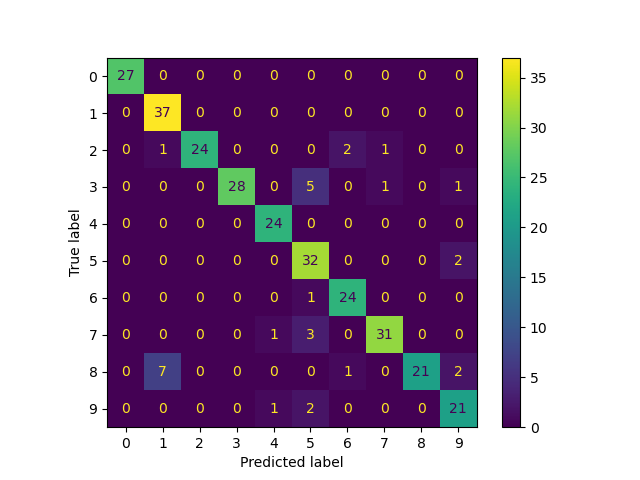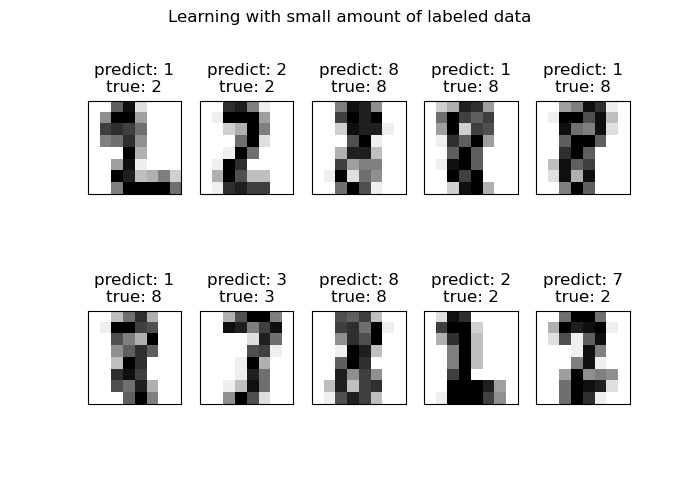Note
Click here to download the full example code or to run this example in your browser via Binder
Label Propagation digits: Demonstrating performance¶
This example demonstrates the power of semisupervised learning by training a Label Spreading model to classify handwritten digits with sets of very few labels.
The handwritten digit dataset has 1797 total points. The model will be trained using all points, but only 30 will be labeled. Results in the form of a confusion matrix and a series of metrics over each class will be very good.
At the end, the top 10 most uncertain predictions will be shown.
# Authors: Clay Woolam <clay@woolam.org>
# License: BSD
Data generation¶
We use the digits dataset. We only use a subset of randomly selected samples.
from sklearn import datasets
import numpy as np
digits = datasets.load_digits()
rng = np.random.RandomState(2)
indices = np.arange(len(digits.data))
rng.shuffle(indices)
We selected 340 samples of which only 40 will be associated with a known label. Therefore, we store the indices of the 300 other samples for which we are not supposed to know their labels.
X = digits.data[indices[:340]]
y = digits.target[indices[:340]]
images = digits.images[indices[:340]]
n_total_samples = len(y)
n_labeled_points = 40
indices = np.arange(n_total_samples)
unlabeled_set = indices[n_labeled_points:]
Shuffle everything around
y_train = np.copy(y)
y_train[unlabeled_set] = -1
Semi-supervised learning¶
We fit a LabelSpreading and use it to predict
the unknown labels.
from sklearn.semi_supervised import LabelSpreading
from sklearn.metrics import classification_report
lp_model = LabelSpreading(gamma=0.25, max_iter=20)
lp_model.fit(X, y_train)
predicted_labels = lp_model.transduction_[unlabeled_set]
true_labels = y[unlabeled_set]
print(
"Label Spreading model: %d labeled & %d unlabeled points (%d total)"
% (n_labeled_points, n_total_samples - n_labeled_points, n_total_samples)
)
Label Spreading model: 40 labeled & 300 unlabeled points (340 total)
Classification report
print(classification_report(true_labels, predicted_labels))
precision recall f1-score support
0 1.00 1.00 1.00 27
1 0.82 1.00 0.90 37
2 1.00 0.86 0.92 28
3 1.00 0.80 0.89 35
4 0.92 1.00 0.96 24
5 0.74 0.94 0.83 34
6 0.89 0.96 0.92 25
7 0.94 0.89 0.91 35
8 1.00 0.68 0.81 31
9 0.81 0.88 0.84 24
accuracy 0.90 300
macro avg 0.91 0.90 0.90 300
weighted avg 0.91 0.90 0.90 300
Confusion matrix
from sklearn.metrics import ConfusionMatrixDisplay
ConfusionMatrixDisplay.from_predictions(
true_labels, predicted_labels, labels=lp_model.classes_
)

<sklearn.metrics._plot.confusion_matrix.ConfusionMatrixDisplay object at 0x7fd05ed4df10>
Plot the most uncertain predictions¶
Here, we will pick and show the 10 most uncertain predictions.
from scipy import stats
pred_entropies = stats.distributions.entropy(lp_model.label_distributions_.T)
Pick the top 10 most uncertain labels
uncertainty_index = np.argsort(pred_entropies)[-10:]
Plot
import matplotlib.pyplot as plt
f = plt.figure(figsize=(7, 5))
for index, image_index in enumerate(uncertainty_index):
image = images[image_index]
sub = f.add_subplot(2, 5, index + 1)
sub.imshow(image, cmap=plt.cm.gray_r)
plt.xticks([])
plt.yticks([])
sub.set_title(
"predict: %i\ntrue: %i" % (lp_model.transduction_[image_index], y[image_index])
)
f.suptitle("Learning with small amount of labeled data")
plt.show()

Total running time of the script: ( 0 minutes 0.332 seconds)